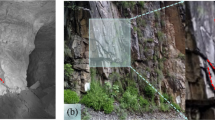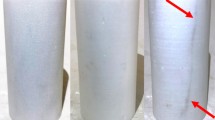Abstract
The shear behavior of the discontinuities has a significant influence on the stability of rock engineering. In this paper, the numerical and experimental direct shear tests were performed to investigate the shear behavior of non-persistent jointed rocks. Through a comprehensive calibration of shear stress-displacement curves and failure mode, good agreement was successfully achieved. Further numerical analysis was conducted to study the macro–micro failure mechanism. The results indicate that the shear failure of fractured rock mass begins at the end of crack in the rock mass where the crack initiation appears and as the crack expands inward of rock a macroscopic shear fracture zone is formed along the fracture plane finally. The rotation radian of particles appears obvious zoned phenomenon. The particles with larger rotation radian are mainly distributed at the location where the cracks occurred. The process of specimen failure is the process of unceasing redistribution of the rotation radians of particles inside the specimen. The distribution of contact force is obviously regional and directional and the distribution area of crack is always consistent with that of compressive stress concentration. The failure process of rock is the process of energy dissipation within the specimen, and the failure of the specimen is a kind of instability phenomenon driven by energy.













Similar content being viewed by others
References
Azevedo NM, Candeias M, Gouveia F (2015) A rigid particle model for rock fracture following the Voronoi tessellation of the grain structure: formulation and validation. Rock Mech Rock Eng 48(2):535–557
Bai S, Ren W, Zhou S, Feng D (1999) Research on the strength behavior of rock containing coplanar close intermittent joints by direct shear test. Rock Soil Mech 20(2):10–16
Barton N, Choubey V (1977) The shear strength of rock joints in theory and practice. Rock Mech 10(1–2):1–54
Bewick RP, Kaiser PK, Bawden WF et al (2014a) DEM simulation of direct shear: 1. Rupture under constant normal stress boundary conditions. Rock Mech Rock Eng 47(5):1647–1671
Bewick RP, Kaiser PK, Bawden WF (2014b) DEM simulation of direct shear: 2. Grain boundary and mineral grain strength component influence on shear rupture. Rock Mech Rock Eng 47(5):1673–1692
Cai M (2013) Rock mechanical and engineering. Science Press, Beijing
Gehle C, Kutter HK (2003) Breakage and shear behaviour of intermittent rock joints. Int J Rock Mech Min Sci 40(5):687–700
Jiang Y, Luan H, Wang Y et al (2018) Study on macro-meso failure mechanism of pre-fractured rock specimens under uniaxial compression. Geotech Geol Eng 36(5):3211–3222
Lajtai EZ (1969a) Shear strength of weakness planes in rock. Int J Rock Mech Min Sci Geomech Abstr 6(5):499
Lajtai EZ (1969b) Strength of discontinuous rocks in direct shear. Geotechnique 19(2):218–233
Li X, Li H, Xia X, Liu B, Feng H (2016) Numerical simulation of mechanical characteristics of jointed rock in direct shear test. Rock Soil Mech 2(37):583– 591
Li S, Wang S, Wang Z (2018) Microparameter estimation method of concrete micro-constitutive model based on Brazilian test. J Shandong Univ Sci Technol (Natural Science) 37(4):49–57
Liu Y (2007) Study on failure models and strength of rock mass containing discontinuous joints in direct shear. College of Civil Engineering, Tongji University, Shanghai
Liu Y, Xia C (2006) Study on models and strength behavior of rock mass containing discontinuous joints in direct shear. Chin J Geotech Eng 28(10):1242–1247
Potyondy DO (2007) Simulating stress corrosion with a bonded-particle model for rock. Int J Rock Mech Min Sci 44(5):677–691
Qing Y, Feng J, Yang S, Ren Q (2018) Formation mechanism and evolution of multi-phase fault based on physical and numerical simulation. J Shandong Univ Sci Technol (Natural Science) 37(1):60–70
Ren W, Bai S, Feng D, Chen J, Jia Z (2000) Strength behavior of rock mass containing coplanar close intermittent joints under direct shear condition. Chinese Society for Rock Mechanics & Engineering, Wuhan
Son BK, Lee YK, Lee CI (2004) Elastic–plastic simulation of a direct shear test on rough rock joints. Int J Rock Mech Min Sci 41(3):354–359
Stimpson B (1978) Failure of slopes containing discontinuous planar points. In: 19th US symposium on rock mechanics (USRMS). American Rock Mechanics Association
Svartsjaern M, Saiang D (2017) Discrete element modelling of footwall rock mass damage induced by sub-level caving at the Kiirunavaara mine. Minerals 7(7):109
Wang X, Wang G, Jiang Y, Wu X, Wang Z, Huang N (2014a) Simulation research on granite compression test based on particle discrete element model. Rock Soil Mech z1:99–105
Wang G, Yuan K, Jiang Y, Shi Y, Chen L, Han Z (2014) Macro-micro mechanical study on bolted joint subjected to shear loading based on DEM. J China Coal Soc 39(12):2381–2389
Xu J, Xie Z, Jia H (2010) Simulation of micromechanical properties of limestone using particle flow code. In: National symposium on numerical analysis and analytical methods of geotechnical mechanics, Wenzhou
Yan P, Li T, Lu W, Chen M, Zhou C (2013) Properties of excavation damaged zone under blasting load in deep tunnels. Rock Soil Mech 34(z1):451–457
Yang Q, Liu Y (2012) Simulations of crack propagation in rock-like materials using particle flow code. Chin J Rock Mech Eng 31(s1):3123–3129
Yang S, Tian W, Ranjith PG (2017) Failure mechanical behavior of Australian strathbogie granite at high temperatures: insights from particle flow modeling. Energies 10(6):756
Yu H, Ruan H, Chu W (2013) Particle flow code modeling of shear behavior of rock joints. Chin J Rock Mech Eng 32(7):1482–1490
Zhao J (1997) Joint matching coefficient and effects to behavior of rock joint. Chin J Rock Mech Eng 16(6):514
Zhao J (1998) A new JRC-JMC shear strength criterion for rock joints. Chin J Rock Mech Eng 4:349–357
Zhao L, Feng J (2018) Interrelationship study between rock mechanical stratigraphy and structural fracture development. J Shandong Univ Sci Technol (Natural Science) 37(1):35–46
Zhou J, Zhang L, Yang D et al (2017a) Investigation of the quasi-brittle failure of alashan granite viewed from laboratory experiments and grain-based discrete element modeling. Materials 10(7):835
Zhou J, Zhang L, Braun A et al (2017b) Investigation of processes of interaction between hydraulic and natural fractures by PFC modeling comparing against laboratory experiments and analytical models. Energies 10(7):1001
Acknowledgements
This work is supported by the National Natural Science Foundation of China (Nos. 51379117 and 51479108), Scientific Research Foundation of Shandong University of Science and Technology for Recruited Talents (2015RCJJ048) and Provincial Natural Science Foundation of Shandong Province, China (ZR2017PEE018).
Author information
Authors and Affiliations
Corresponding author
Additional information
Publisher's Note
Springer Nature remains neutral with regard to jurisdictional claims in published maps and institutional affiliations.
Rights and permissions
About this article
Cite this article
Jiang, Y., Yan, P., Wang, Y. et al. Numerical Investigations on Shear Behavior and Failure Mechanism of Non-persistent Jointed Rocks. Geotech Geol Eng 38, 1639–1651 (2020). https://doi.org/10.1007/s10706-019-01119-1
Received:
Accepted:
Published:
Issue Date:
DOI: https://doi.org/10.1007/s10706-019-01119-1




